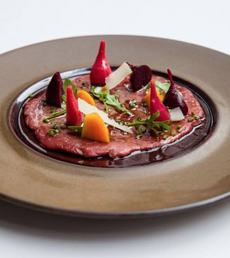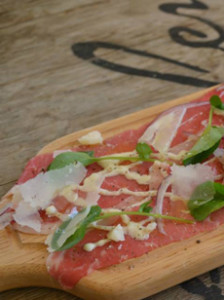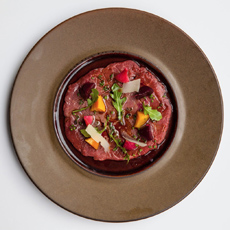FOOD FUN: “Stonehenge” Beef Carpaccio

|
We’re starting the new year of Food Fun with this eye-catching, low calorie treat.
We love the eye appeal of the food at All’Onda in New York City. Take this “Stonehenge” Beef Carpaccio. Cut beets are arranged in a circle in an homage to the giant standing stones of Stonehenge. Carpaccio (car-POTCH-yo) is a very popular first course in Italy. Paper-thin slices of beef tenderloin are topped with arugula and shaved cheese, traditionally Parmigiano-Reggiano, and a drizzle of olive oil. On top of those basics, the cook can add anything that he/she likes. So consider what else you’d like to include in your own carpaccio. How about baby spinach, pieces of blood orange, capers or caperberries, cherry or grape tomatoes, gourmet sprouts, onions/green onions/chives, and for those who are blessed financially, white truffles in season (the season is now). The chef at All’Onda chose baby beets and you can, too. The dressing can be fine olive oil or herb-infused oil (basil or rosemary are best) with a slice of lemon or lime. It could be a vinaigrette; or it could be something fusion. We like ponzu sauce, which we used in our re-creation of this recipe. Serve the carpaccio with sliced baguette or crusty sourdough, plain or toasted, along with a peppermill. |
|
|
RECIPE: STONEHENGE CARPACCIO Total preparation time is 2 hours 35 minutes, of which two hours is chilling time in the freezer. The biggest challenge you’ll have is slicing the beef thinly and evenly. Sharpen that knife! Ingredients For 4 Servings †American “Romano” cheese is a mild cheese not related to Italian Peorino Romano, which is salty and flavorful like Parmigiano-Reggiano. See our Cheese Glossary for more information. |
||
|
Preparation 1. FREEZE the beef briefly to make it easier to cut. Cloak it tightly with plastic wrap and place it in the freezer for 2 hours. Chill the plates in the refrigerator. 2. REMOVE the beef from the freezer and thinly slice it into pieces approximately 1/8″ to 1/4″ thick. Lay out sheets of plastic wrap and place each slice onto the wrap as you slice it. Top the slices with another piece of plastic wrap and gently pound the meat with a mallet until the slices are paper thin. 3. DIVIDE the beef onto the four plates, creating a neat circle or other artful layout. Toss the greens lightly in the balsamic vinaigrette. Arrange the beets into “Stonehenge.” pepper and/or 4. TOP with the shaved cheese and serve, passing the peppermill and the bread. CARPACCIO VS. CRUDO Sometimes we see “Tuna Carpaccio” or other seafood carpaccio (octopus, salmon, scallops, etc.) on a menu. That’s incorrect; feel free to point it out to the chef. (Seriously: We once had to tell a two-star chef, via our waiter, that his menu featured bison, not buffalo). |
 Don’t want to create Stonehenge? The same ingredients make a conventional beef carpaccio. This one, from Firenze Osteria, is slightly less conventional: It substitutes aïoli—garlic mayonnaise—for the olive oil. |
|
|
Just because they’re acclaimed doesn’t mean that they’re correct.) Carpaccio is raw beef filet, typically sirloin; crudo is the term for raw fish or seafood. Crudo is analogous to sashimi or tiradito, but the fish is cut differently. While crudo has been eaten for millennia*, carpaccio is a modern dish, created in Venice in 1963, at the time of an exhibition dedicated to Venetian painter Vittore Carpaccio (1465-1526). The carpaccio dish was based on the Piedmont speciality, carne cruda all’albese, created by Giuseppe Cipriani, founder of Harry’s Bar in Venice. Using fine Piedmontese beef (Piemontese in Italian), he originally prepared it for a countess whose doctors had recommended that she eat raw meat!
|
||



